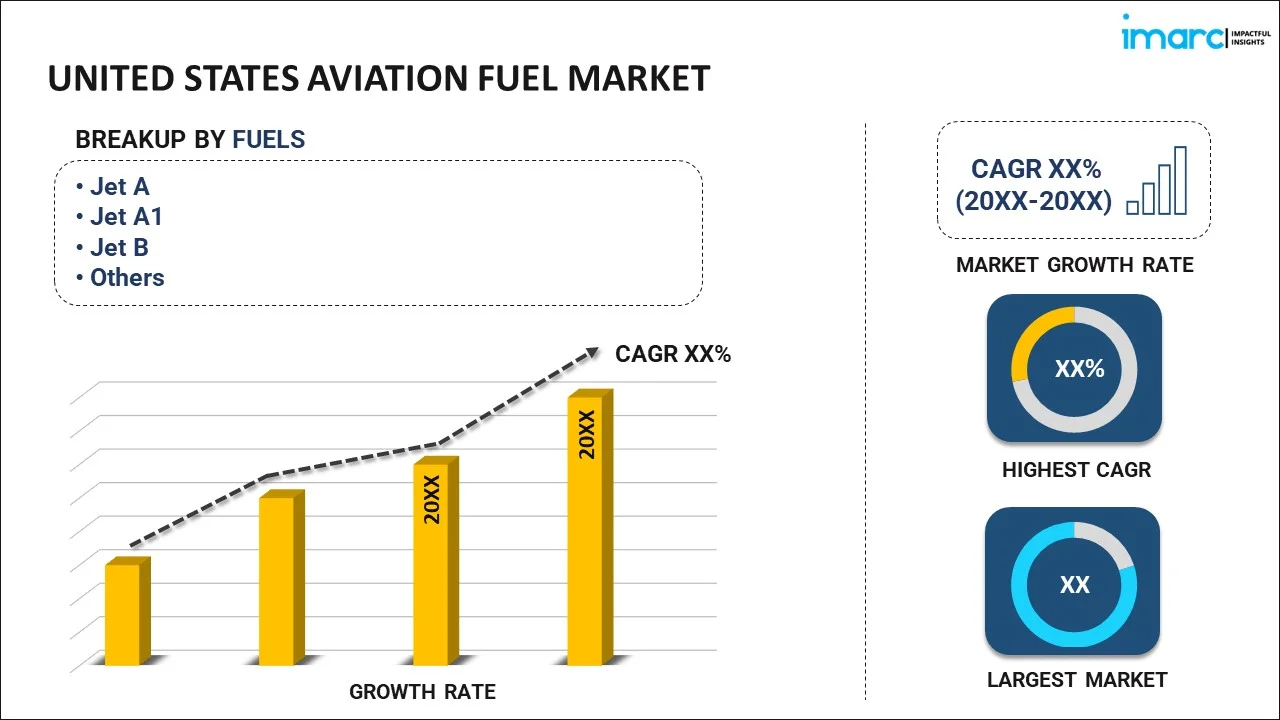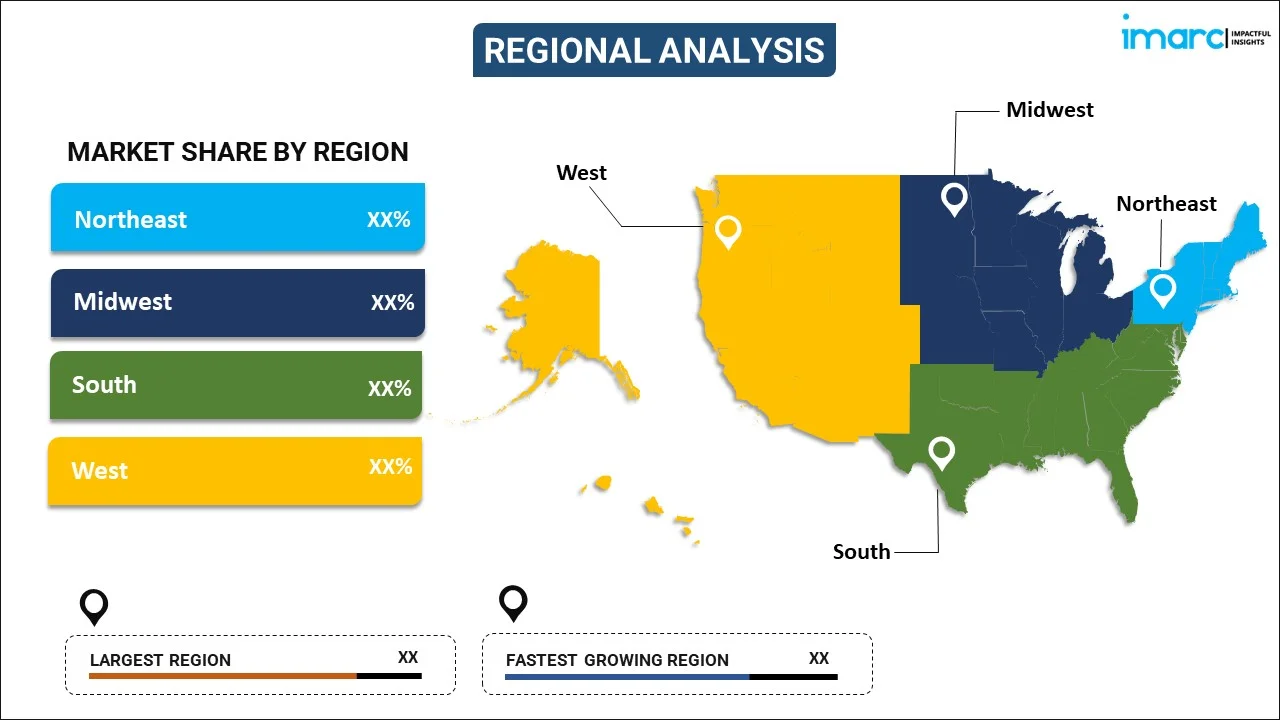
United States Aviation Fuel Market Report by Fuel (Jet A, Jet A1, Jet B, JP 5, JP 8, Avgas, Biofuel), Aircraft (Fixed Wings, Rotorcraft, and Others), End Use (Commercial, Military, Private, and Others), and Region 2025-2033
Market Overview:
United States aviation fuel market size is projected to exhibit a growth rate (CAGR) of 7.12% during 2025-2033. The market is experiencing growth due to factors, such as the rising volume of air travelers, evolving modifications in airline operations, and the expanding aviation industry.
|
Report Attribute
|
Key Statistics
|
|---|---|
|
Base Year
|
2024 |
|
Forecast Years
|
2025-2033 |
|
Historical Years
|
2019-2024
|
| Market Growth Rate (2025-2033) | 7.12% |
United States Aviation Fuel Market Analysis:
- Major Market Drivers: The market is bolstered by heightening passenger traffic, improving cargo operations, and increasing defense aviation. Recent United States aviation fuel market analysis indicates that efficiency-driven refining technologies and cleaner standards of emissions are largely impacting demand, propelling overall growth momentum and sustainability uptake.
- Key Market Trends Sustainable aviation fuels, biofuel blending programs, and airline and energy company partnerships are becoming prevalent trends. With robust policy support and greenhouse gas reduction goals, the United States is moving rapidly toward green aviation fuel to improve resilience and minimize long-term environmental effects.
- Competitive Landscape: The industry has a high level of competition among refiners, oil companies with integration. Increased infrastructure and strategic alliances enhance operations. Most importantly, the United States aviation fuel market share is becoming more influenced by sustainable fuel uptake and competitive supply dependability throughout the aerospace community.
- Opportunities and Challenges: Price volatility of crude oil, regulatory, and logistical inefficiencies are still issues for fuel suppliers. Moreover, government incentives, airport development, and green fuel technology offer opportunities with avenues for enhancing efficiency, enhancing energy security, and increasing the competitiveness of U.S. aviation fuel producers.
Aviation fuel, a meticulously refined petroleum-derived fuel, is formulated to deliver optimal energy output while minimizing emissions. Possessing higher energy content and density, this fuel enables aircraft to cover extensive distances at elevated speeds. Enhanced with additives like antioxidants, antistatic agents, and corrosion inhibitors, aviation fuel undergoes treatment to augment its performance and safety features. The advantages it provides to aircraft include stability, lubricity, fluidity, volatility, non-corrosivity, cleanliness, and a preventive measure against explosion risks. To guarantee safe utilization within aircraft, specialized equipment is employed for the storage and transportation of aviation fuel. This specialized equipment is crucial for averting leaks and minimizing the potential risk of fire during the handling and operation of aviation fuel.
United States Aviation Fuel Market Trends:
Increased Adoption of Sustainable Aviation Fuels
The United States aviation industry is highly turning to sustainable aviation fuels (SAFs) as a viable means of decarbonizing aviation while adhering to future emission reduction targets. Incentivization by governments, investments in research, and joint collaborations between aviation regulators and fuel manufacturers are facilitating SAF adoption on a larger scale. Mixing biofuels with traditional jet fuel not only decreases greenhouse gas emissions but is also enhancing the long-term energy security of the aviation industry. Airlines are starting to bring SAF into commercial operations, while cargo and defense aviation markets are looking into scalable roll-out. The shift benefits global sustainability goals and places the United States as the front-runner in cleaner aviation solutions. By increasing efficiency, reducing lifecycle emissions, and ensuring supply chains, SAF deployment has a key role in ensuring United States aviation fuel market growth as it meets rising consumer and regulatory demands for environmentally friendly travel.
Air Passenger and Cargo Operations Growth
The consistent passenger volume growth and cargo operations are impacting the United States aviation fuel outlook in a major way. High economic activity, growth of tourism, and trade revival are all increasing air traffic on both domestic and international routes. Commercial carriers are countering with higher frequencies and long-haul flights, leading to amplified fuel usage. Concurrently, the rise in e-commerce and logistics services is driving demand for special cargo flights, further justifying the need for safe and efficient aviation fuel supply. Airports nationwide are increasing infrastructure to support non-stop activity, providing more capacity for fueling processes. The ongoing growth in passenger traffic and strong cargo movement is bolstering United States aviation fuel market demand and highlighting the role fuel efficiency and availability play in maintaining overall aviation sector performance throughout commercial and freight operations.
Technological Innovations in Refining and Fuel Efficiency
Refinery process innovation and fuel formulation innovation are shaping the future of aviation fuels in the United States. Future-proofing hydro processing, catalytic cracking, and clean fuels technology is improving the efficiency, stability, and quality of aviation fuels to meet changing environmental standards. These new technologies optimize performance while also prolonging engine life, improving fuel economy, and decreasing operating expense for operators. In addition, additive technology innovations are solidifying combustion properties and reducing emissions, thus positioning aviation fuel manufacturing to meet worldwide climate objectives. These innovations are also instrumental in ensuring the promotion of alternative feedstocks, such as bio-based materials, into the conventional fuel supplies. Through emphasis on efficiency, sustainability, and operational dependability, the industry continues to reap the advantages of innovation that guarantees fuel production resilience. These trends are fundamental in strengthening the long-term market competitiveness while in accordance with international energy transition priorities.
United States Aviation Fuel Market Segmentation:
IMARC Group provides an analysis of the key trends in each segment of the market, along with forecasts at the country level for 2025-2033. Our report has categorized the market based on fuel, aircraft, and end use.
Fuel Insights:

To get more information on this market, Request Sample
- Jet A
- Jet A1
- Jet B
- JP 5
- JP 8
- Avgas
- Biofuel
The report has provided a detailed breakup and analysis of the market based on the fuel. This includes jet A, jet A1, jet B, JP 5, JP 8, avgas, and biofuel.
Aircraft Insights:
- Fixed Wings
- Rotorcraft
- Others
A detailed breakup and analysis of the market based on the aircraft have also been provided in the report. This includes fixed wings, rotorcraft, and others.
End Use Insights:
- Commercial
- Military
- Private
- Others
The report has provided a detailed breakup and analysis of the market based on the end use. This includes commercial, military, private, and others.
Regional Insights:

- Northeast
- Midwest
- South
- West
The report has also provided a comprehensive analysis of all the major regional markets, which include Northeast, Midwest, South, and West.
Competitive Landscape:
The market research report has also provided a comprehensive analysis of the competitive landscape. Competitive analysis such as market structure, key player positioning, top winning strategies, competitive dashboard, and company evaluation quadrant has been covered in the report. Also, detailed profiles of all major companies have been provided.
Latest News and Developments:
- In June 2025, JetZero is progressing with its blended-wing aircraft concept that aims to reduce fuel consumption and emissions by 50 percent, a development with significant implications for the United States aviation fuel market. Supported by airline partnerships and U.S. Air Force investment, the company targets a demonstrator flight in 2027, highlighting a step forward in sustainable aviation.
- In May 2024, LanzaJet opened the world's first commercial-scale ethanol-to-sustainable aviation fuel facility, Freedom Pines Fuels, that will produce 9 million gallons of SAF and 1 million gallons of renewable diesel per year. Having secured customers until 2034, the project represents a turning point in revolutionizing United States aviation fuel supply.
United States Aviation Fuel Market Report Coverage:
| Report Features | Details |
|---|---|
| Base Year of the Analysis | 2024 |
| Historical Period | 2019-2024 |
| Forecast Period | 2025-2033 |
| Units | Million USD |
| Scope of the Report | Exploration of Historical Trends and Market Outlook, Industry Catalysts and Challenges, Segment-Wise Historical and Future Market Assessment:
|
| Fuels Covered | Jet A, Jet A1, Jet B, JP 5, JP 8, Avgas, Biofuel |
| Aircrafts Covered | Fixed Wings, Rotorcraft, Others |
| End Uses Covered | Commercial, Military, Private, Others |
| Regions Covered | Northeast, Midwest, South, West |
| Customization Scope | 10% Free Customization |
| Post-Sale Analyst Support | 10-12 Weeks |
| Delivery Format | PDF and Excel through Email (We can also provide the editable version of the report in PPT/Word format on special request) |
Key Questions Answered in This Report:
- How has the United States aviation fuel market performed so far and how will it perform in the coming years?
- What has been the impact of COVID-19 on the United States aviation fuel market?
- What is the breakup of the United States aviation fuel market on the basis of fuel?
- What is the breakup of the United States aviation fuel market on the basis of aircraft?
- What is the breakup of the United States aviation fuel market on the basis of end use?
- What are the various stages in the value chain of the United States aviation fuel market?
- What are the key driving factors and challenges in the United States aviation fuel?
- What is the structure of the United States aviation fuel market and who are the key players?
- What is the degree of competition in the United States aviation fuel market?
Key Benefits for Stakeholders:
- IMARC’s industry report offers a comprehensive quantitative analysis of various market segments, historical and current market trends, market forecasts, and dynamics of the United States aviation fuel market from 2019-2033.
- The research report provides the latest information on the market drivers, challenges, and opportunities in the United States aviation fuel market.
- Porter's five forces analysis assist stakeholders in assessing the impact of new entrants, competitive rivalry, supplier power, buyer power, and the threat of substitution. It helps stakeholders to analyze the level of competition within the United States aviation fuel industry and its attractiveness.
- Competitive landscape allows stakeholders to understand their competitive environment and provides an insight into the current positions of key players in the market.
Need more help?
- Speak to our experienced analysts for insights on the current market scenarios.
- Include additional segments and countries to customize the report as per your requirement.
- Gain an unparalleled competitive advantage in your domain by understanding how to utilize the report and positively impacting your operations and revenue.
- For further assistance, please connect with our analysts.
 Request Customization
Request Customization
 Speak to an Analyst
Speak to an Analyst
 Request Brochure
Request Brochure
 Inquire Before Buying
Inquire Before Buying




.webp)




.webp)












